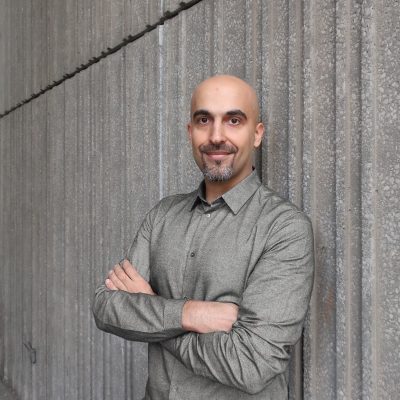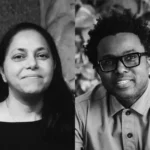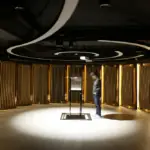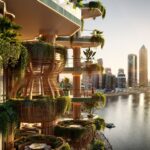Sharjah Architecture Triennial 2023 architects, UAE building exhibition designers, New Dubai architecture images
Sharjah Architecture Triennial 2023 News
2 May 2025
Sharjah Architecture Triennial 2026 Curator News
Left: Vyjayanthi Rao, Right: Tau Tavengwa:
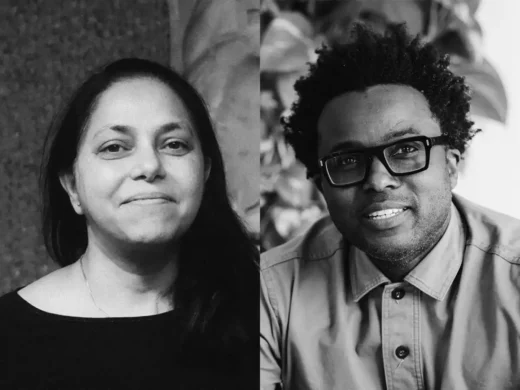
Photographed by Alfonse Chiu. Image courtesy of Vyjayanthi Rao ; Photographed by Samer Moukarzel. Image courtesy of Tau Tavengwa
Sharjah Architecture Triennial 2026
26 September 2023
Location: Sharjah, UAE
Sharjah Architecture Triennial 2023 Reveals Details Of New Commissions And Site-specific Projects
The Beauty of Impermanence: An Architecture of Adaptability curated by Tosin Oshinowo
11 November 2023 – 10 March 2024
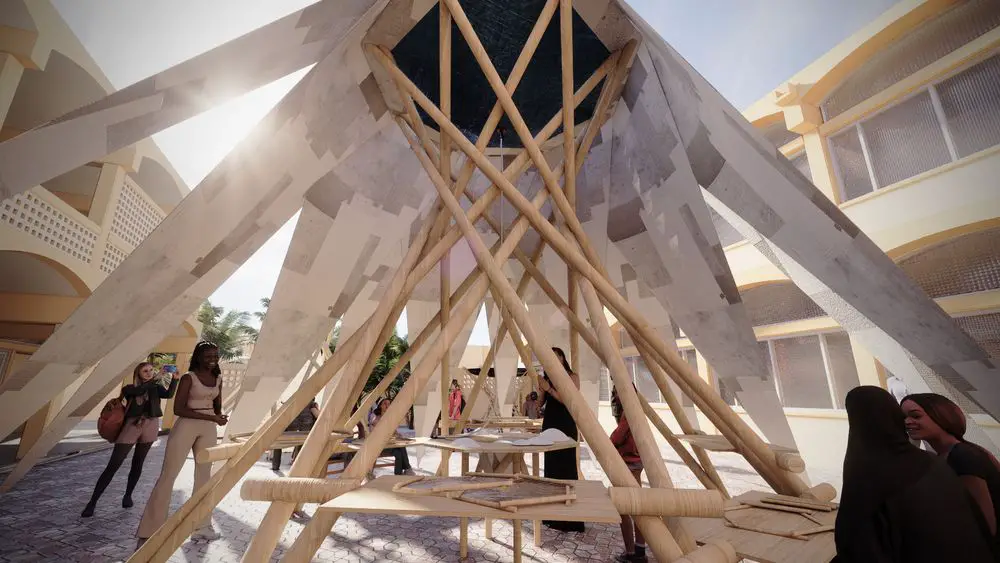
Collab – Henry Glogau & Aleksander Kongshaug, Render of Resource Autonomy
Images credits can be found in captions.
Sharjah Architecture Triennial 2023 commissions and projects
Sharjah Architecture Triennial reveals details of new commissions and site-specific projects for its 2023 edition, The Beauty of Impermanence: An Architecture of Adaptability. Curated by architect Tosin Oshinowo, the Triennial will feature 30 architects, designers and studios from 26 countries, who will explore innovative design solutions borne out of conditions of scarcity in the Global South. From large-scale installations and exhibitions to critical conversations and wider public programming, the Triennial will examine how cultures of re-use, re-appropriation, collaboration and adaptation can help to deliver a more sustainable, resilient and equitable future.
The Triennial was first established in 2018 to provide a platform for architecture and urbanism from West Asia to South Asia and the African continent, framed within the context of Sharjah. Projects will be displayed across the city and its environs, from central locations such as the old Al Jubail Vegetable Market and the Al Qasimiyah School to the surrounding desert. The edition will immerse visitors in an ambitious and dynamic presentation that, while rooted in the history, culture and tradition of Sharjah, transforms the region into a global hub for architectural discourse.
Renowned for her environmentally and socially responsive approaches to architecture, Oshinowo’s choice of theme is inspired by her own design philosophy, which embraces contextual solutions. The Triennial’s participants will shine a spotlight on design solutions that draw from indigenous knowledge, explore the potential of local materials, and examine the climate resilience and adaptability of communities around the world.
Projects will respond to the theme across three key strands:
Renewed contextual
From climate change to resource scarcity, participants will demonstrate how knowledge derived from the Global South can inspire resilient design. Projects highlighting the versatility of natural materials as a building resource include ETA’DAN by Hive Earth, a multi-functional wall made of rammed earth and agro-waste. An interactive installation for all ages with seating and steps for rest and relaxation, it will promote sustainability through resource sharing and waste reuse. Employing mud as material is also the foundation for Sumaya Dabbagh’s EARTH TO EARTH, a curved wall structure that reflects the fundamental circularity and duality of a material which embodies both solidity and fluidity.
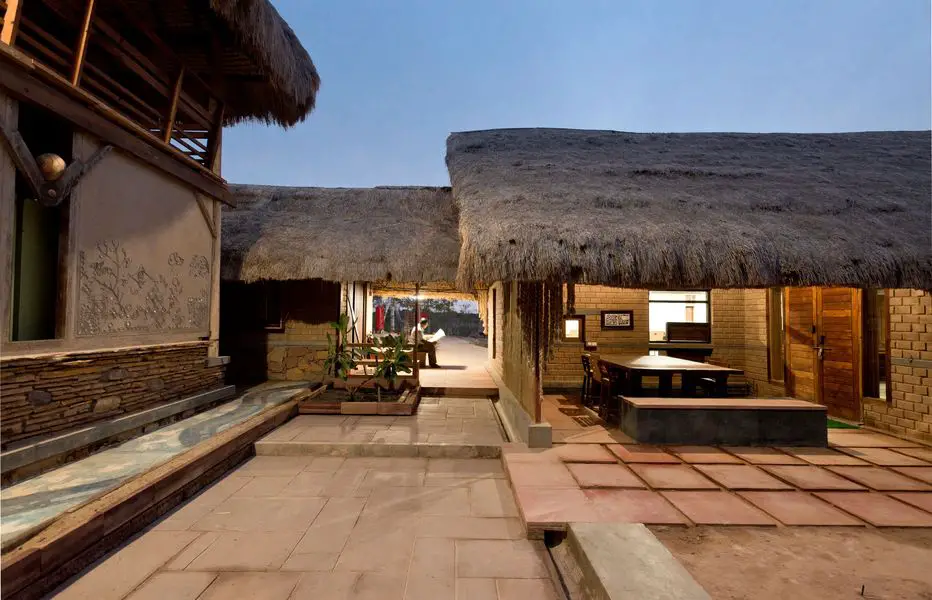
Hunnarshala Campus, Bhuj. Image Courtesy of Andreas Deffner
Addressing the extractive impact of modern market economies on biodiversity and indigenous knowledge, Hunnarshala Foundation’s Back to the Future is an exhibition that will explore how natural materials and traditional building skills can strengthen marginalised voices. Also acknowledging indigenous practices, artist and architect Abeer Seikaly will present a mobile cultural space that celebrates the significance of weaving within Bedouin communities. The construction will use locally sourced bamboo and goat’s hair, envisioning a circular future whilst evoking the forgotten relationship between people and the land.
Projects will also highlight innovative responses, and resistance to, waste culture. Thomas Egoumenides’ Ship of Theseus, embraces a circular approach using discarded plastic spools and threaded rods. Repurposing these materials to craft an architectural installation, the project becomes a symbol of resistance to a throwaway culture. A project by Papa Omotayo & Eve Nnaji MOE+AA/ADD-apt will be based in one of Sharjah’s industrial zones, exploring life amid the area’s vacant lots and unutilised spaces. WE REST AT THE BIRD’S NEST is an installation constructed from organic waste and scaffolding that asks what happens when space is adapted to create a collective point of rest.
Extraction politics
Participants will also engage in documenting, recording, and addressing the extractive processes that often underpin design. Cambio (2020-2023) is an ongoing project by Formafantasma, which investigates the wood industry’s origins in colonial bioprospecting in the nineteenth century. It explores the supply chain’s environmental impacts and seeks to expand design beyond finished products by integrating forestry, legislation, science and activism. Through videos presented as part of a multidisciplinary exhibition, they ask how design can address environmental issues through collaborative and informed approaches.
Highlighting the issue of waste colonialism, clothing brand BUZIGAHILL – who creatively transform second-hand clothing waste from the West and sell it back to the Global North – will reconstruct their production studio and stage RETURN TO SENDER. This defiant performance showcases the resourcefulness of Sub-Saharan Africans in harnessing waste as a valuable resource. Sharjah plays a significant role in the second-hand clothing supply chain, and bales of unwashed second-hand clothing have been specially acquired for the performance from a sorting centre in one of Sharjah’s Free Zones, where migrant workers unpack, sort and repack unwanted clothes collected in Europe.
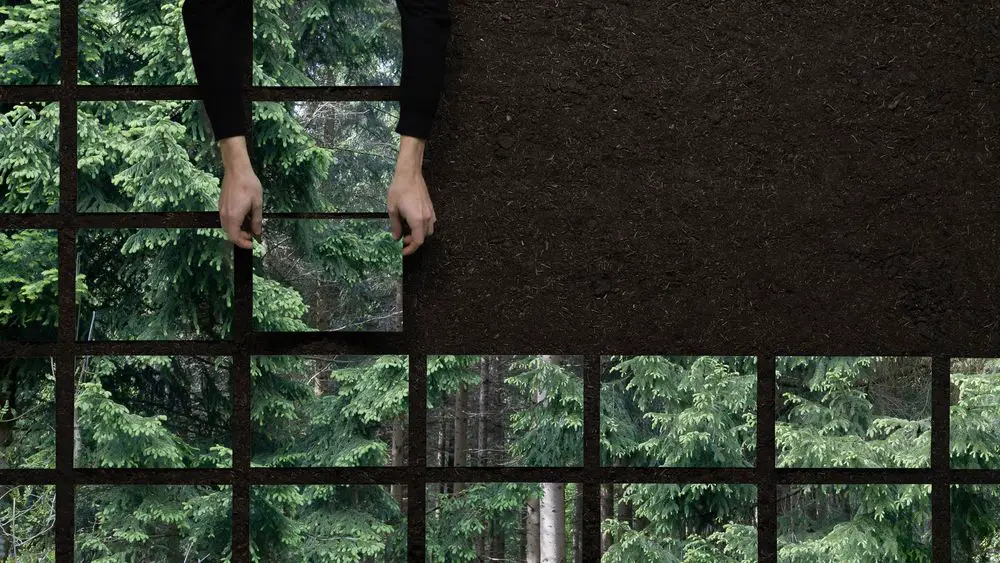
Formafantasma, Still from “Cambio – Seeing the Wood for the Trees” (2020-2023)
Power Shifts is a photographic installation by Dia Mrad that looks at Lebanon’s economic collapse using aerial imagery of the proliferation of solar panels on rooftops in Beirut. Viewed not just as objects, the panels become manifestations of the crisis itself, inviting viewers to reflect on not only the visual impact of the economic collapse on the cityscape, but also its profound effect on the lives of its residents.
In response to Sharjah’s evolving national identity and cultural significance in the UAE, Olalekan Jeyifous will present SHJ 1X72 – 1X89, a speculative work that offers a retro-futurist vision of the region. Set on Sharjah’s Bank Street and its ‘heritage areas’, Jeyifous will imagine an alternative architecture that embraces sustainable practices and local typologies, in tune with the climatic conditions of the region and the social rhythms of its inhabitants.
Intangible bodies
Participants will celebrate the ephemeral nature of civilisation’s interaction with the environment, with projects exploring how natural landscape systems and cultural narratives can be integrated into new urban frameworks. Abandoned sites in Sharjah, UAE, will provide a catalyst for many of these ideas, such as the old Al Jubail Vegetable Market, which closed in 2015 but was saved from demolition by SAT in 2019. 51-1 Arquitectos will turn the area adjacent to the venue into Play You Are in Sharjah, a public space for communal activity with tables, chairs and board games that are reconfigured according to the position of the sun throughout the day.
Elsewhere, in the desert surrounding the city, the Al Madam ‘ghost village’ is part of a series of modernist settlements that were built in the 1970s to house nomadic groups. Long since abandoned, DAAR – Sandra Hilal & Alessandro Petti’s project Concrete Tent will use fabric to cover the ruins of the village, reframing it as a symbol of enduring transience. Ultimately, like the buildings, the project will be reclaimed by the dunes, a poetic reminder of the inevitability of impermanence.
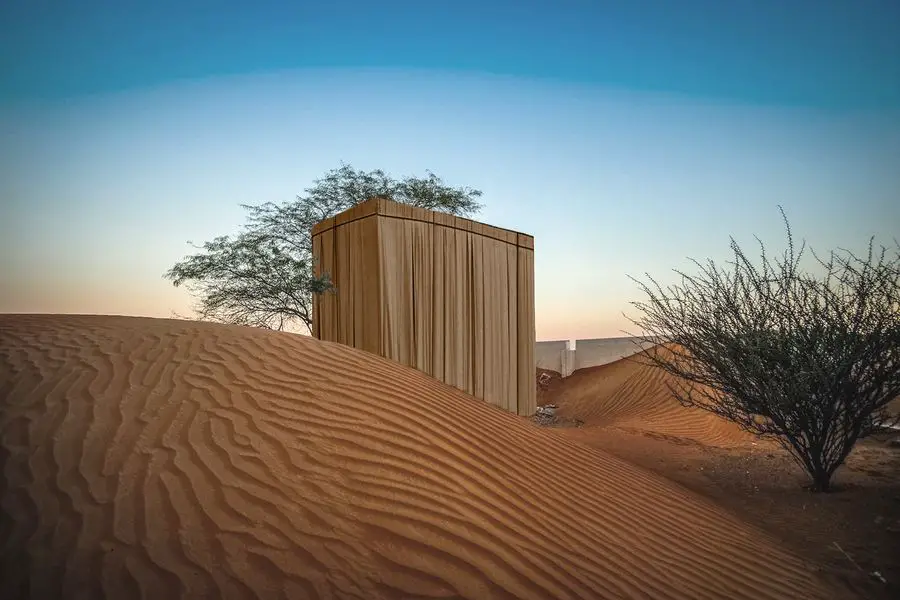
Rendering of wrapped building in Al Madam. Image Courtesy of Herman Hjorth Berge
Honouring architecture as a space for ritual, performance and tradition, Yussef Agbo-Ola will present JABALA 9: ASH CLEANSING TEMPLE. This sacred structure – honouring Bedouin, Yoruba and Cherokee cultures – will be built from organic materials such as jute, hemp and cotton yarn and illustrated with cosmological motifs, inviting visitors to partake in collective incense burning and breathing ceremonies within. The Museum of Artifice by Miriam Hillawi Abraham reimagines the sacred rock-hewn churches of Lalibela in Northern Ethiopia as constructed entirely from blocks of salt – a nod to the material culture of Sharjah and its historic relationship with Ethiopia. The structure will eventually be dismantled and its salt blocks returned to the merchant for re-use in agriculture and construction, only leaving behind remnants of salt, dust, and memories.
The full list of participants: 51-1 Arquitectos (Peru); Abeer Seikaly (Jordan); Adrian Pepe (Honduras/Lebanon); Al Borde (Ecuador); Art and Culture Development Foundation of the Republic of Uzbekistan (ACDF) (Uzbekistan); Asif Khan Studio (UK); Bubu Ogisi (Nigeria); BUZIGAHILL (Uganda); Cave_bureau (Kenya); Collab: Henry Glogau & Aleksander Kongshaug (Denmark/New Zealand); DAAR – Sandi Hilal and Alessandro Petti (Italy/Palestine/Sweden); Dia Mrad (Lebanon); Formafantasma (Italy/Netherlands); Hive Earth (Ghana); Hunnarshala Foundation with Aabhat and Aina (India); Limbo Accra (Ghana); Miriam Hillawi Abraham (Ethiopia); Papa Omotayo & Eve Nnaji MOE+AA/ADD-apt (Nigeria); Natura Futura (Ecuador); Nifemi Marcus-Bello (Nigeria); Ola Uduku and Michael Collins (Nigeria/UK); Olalekan Jeyifous (USA/Nigeria); RUÍNA Architecture (Brazil); Sandra Poulson (UK/Angola); Sumaya Dabbagh (Saudi Arabia/UAE); Thao Nguyen Phan (Vietnam); Thomas Egoumenides (France/Tunisia); Wallmakers (India); Yara Sharif & Nasser Golzari (Palestine/UK); and Yussef Agbo-Ola (UK and Brazil).
About Sharjah Architecture Triennial
Founded in 2018 by Khalid Al Qasimi, Sharjah Architecture Triennial (SAT) is a platform for architecture and urbanism in a region that extends from West Asia to South Asia and the African continent. Physically anchored in Sharjah and the United Arab Emirates, SAT aims to engage diverse audiences and stakeholders in a collective conversation on architecture at the neighbourhood, city, and regional levels. Institutional research and programming support on-going critical reflection through exhibitions, publications, and public programmes in tandem with its international editions. SAT is committed to pursuing a multi-disciplinary approach that fosters an understanding of the broader role of architecture, including its relation to social and environmental issues.
Tosin Oshinowo
Tosin Oshinowo is a Lagos-based Nigerian architect and designer renowned for her expansive residential and commercial spaces and insights into socially-responsive approaches to urbanism. Grounded in a deep respect for Yoruba culture and history, and coming from a markedly African context, Oshinowo’s designs embody a contemporary perspective on the next generation of African design and Afro-minimalism: a responsive reflection of the past, present, and future of architecture and design that prioritises sustainability, resilience, and poise. She is also the curator of the 2023 Sharjah Architecture Triennial.
As an architect, Oshinowo is best known as the founder and principal of cmDesign Atelier (cmD+A), established in 2012. Based in Lagos, the practice has undertaken a number of predominantly civic projects, including the design of the Maryland Mall, as well as a wide range of residential projects, including light-filled beach houses on the coast of the oceanside city. Her interest in architecture extends into a broader vision of urbanism and community; she recently completed a project with the United Nations Development Programme in Northeast Nigeria, building an entirely new community for a village displaced by Boko Haram.
Before founding cmD+A, she worked in the offices of Skidmore Owings & Merrill in London and the Office of Metropolitan Architecture Rotterdam, where she was part of the team that designed the 4th Mainland Bridge proposal in 2008. Returning to Lagos, she practised at James Cubitt Architects and led notable projects, including the masterplan and corporate head office building for Nigeria LNG in Port Harcourt.
As a product designer, her work is primarily focused on chair design; in 2017, she created Ilé-Ilà, which means House of Lines in her native Yoruba language. A luxury brand, Ilé-Ilàchairs are made to order, designed and handmade in Lagos and have been featured as a highlight of contemporary African furniture design in publications around the world, including Harper’s Bazaar Interiors (April 2018), Elle Decor (January 2020) and Grazia (June 2020).
Oshinowo’s work also spans the conceptual sphere, with a strong interest in architectural history and socially- responsive approaches to architecture, design and urbanism, underpinned by a passion for supporting African design and innovation. In 2020, she partnered with Lexus on conceptual design explorations for Design Miami, and she has written prolifically on urbanism, afro modernism, design and identity in publications including Expansions, a publication as part of the 2021 Venice Architecture Biennale and Omenka Online, a topic also explored in her TEDxPortHarcourt talk in November 2017. She also co-curated the second Lagos Biennial titled How to Build a Lagoon from a Bottle of Wine? in 2019.
Oshinowo is a registered architect in the Federal Republic of Nigeria and a member of the Nigerian Institute of Architects, as well as the Royal Institute of the British Architects, with a degree in Architecture from Kingston College in London, a Master’s degree in Urban Design in Development from the Bartlett School of Architecture, a Diploma in Architecture from the Architecture Association London, and a Masters in Business in Architecture and Design from IE University, Madrid. She has won numerous awards, including the 3rd City People Real Estate Awards for Architect of the Year 2017, and the Lord’s Achievers Awards for Creativity, in celebration of World Achievers Day 2019. She was among five finalists for the 2023 Diversity in Architecture Divia Awards.
Hoor Al Qasim
Hoor Al Qasimi is the President, Director and Curator of Sharjah Art Foundation which she established in 2009 as a catalyst and advocate for the arts in Sharjah, UAE, as well as regionally and internationally. With a passion for supporting experimentation and innovation in the arts, Al Qasimi has continuously expanded the scope of the Foundation over its 10-year history to include major exhibitions that have toured internationally; artist and curator residencies in visual art, film and music; commissions and production grants for emerging artists; and a wide range of educational programming in Sharjah for both children and adults. In 2003, Al Qasimi co-curated Sharjah Biennial 6 and has since continued as Biennial Director.
Under Al Qasimi’s leadership, the Sharjah Biennial has become an internationally recognised platform for contemporary artists, curators and cultural producers. Her leadership in the field led to her election as President of the International Biennial Association (IBA) in 2017, an appointment that transferred IBA’s headquarters to Sharjah. Complementing her role at the Foundation, Al Qasimi also serves as the President of The Africa Institute and Chair of the Board for the Sharjah Architecture Triennial, which inaugurated its first edition in November 2019. Al Qasimi served as curator of the second Lahore Biennale, which opened in January 2020 across the city of Lahore, Pakistan.
Al Qasimi serves on the Board of Directors for Kunst-Werke Berlin e. V. in Germany and Ashkal Alwan in Beirut, Lebanon. She is the Chair of the Advisory Board for the College of Fine Arts and Design at the University of Sharjah and is a member of the advisory boards for Khoj International Artists’ Association, New Delhi, India and Darat al Funun, Amman, Jordan.
51-1 Arquitectos
51-1 Arquitectos is an architecture studio based in Lima, Peru, led by Cesar Becerra, Fernando Puente Arnao, and Manuel de Rivero. Since its founding in 2005, the studio has been involved in numerous projects, including housing, public buildings, urban design, hospitality projects, and other research projects. It has received several major awards and recognitions, including four nominations for the Mies Crown Hall Americas Prize. Notably, the studio won the international competition to extend the Medellin Museum of Modern Art in Colombia in 2015. Their portfolio also spans projects across Peru, Ecuador, Russia, and the UAE, including Sharjah Art Foundation’s 2023 Kalba Ice Factory Cultural Centre. In addition to their architectural work, 51-1 Arquitectos has actively engaged in teaching and lecturing at various events and universities. They were selected as curators for the II Architecture Biennial of Lima, scheduled to be held in October 2023. The studio is also a member of Supersudaca, an international collective focused on urban research.
Abeer Seikaly
Abeer Seikaly is a Jordanian-Palestinian interdisciplinary architect, artist and cultural producer. Her practice is rooted in acts of memory – journaling, documenting, archiving, and collecting – and draws inspiration from traditional knowledge in the Arab homeland. She travels to Jordan’s Badia desert, where she engages in Bedouin women’s craftsmanship of textile weaving. Her recent works focus on indigenous Bedouin knowledge and practices, seeking to rediscover the intimacy of handcrafting. Seikaly is the co-founder of Amman Design Week (ADW) and the founder of ālmamar, a cultural experience and residency program in Amman, Jordan. She was appointed as the Louis I Kahn Visiting Assistant Professor at Yale School of Architecture and won the Lexus Design Award for her ongoing work, Weaving a Home. Her works have been exhibited at many institutions: Science Museum, London (2022); Darat Al Funun, Amman (2022); The Miyake Issey Foundation, Tokyo (2021); Espacio Fundación Telefónica, Madrid (2020); MAK – Museum of Applied Arts, Vienna (2018); Stedelijk Museum, Amsterdam (2017); and Museum of Modern Art (MoMA), New York (2016). Her works are also housed in private and public collections: Her Majesty Queen Rania of Jordan, Amman, and Barjeel Art Foundation, Sharjah.
Adrian Pepe
Adrian is a fibre artist presently based in Beirut, Lebanon. Pepe’s artistic practice is an ongoing investigation on material and process. Through his work, he interweaves nature and culture to create objects as tools to enable an open discourse on materiality, our morphing cultural landscape, and our present condition. His most recent and upcoming solo and group exhibitions include Luxembourg Art Week with Galerie La La Lande in Luxembourg (2023). “Fibra” at Extant Fair in Mallorca, Spain (2023); “Fragments of Time Unending” at Nika Project Space, Dubai, UAE (2023); “In/Un Becoming” with Einhoven Design Week (2022); Lost in the Right Direction” with Art Design Lebanon in Beirut, Lebanon (2022). He was selected as a DieDas Fellow in Saaleck, Germany (2022) and participated in artistic residencies including TADA Residency in St Gallen, Switzerland (2023), Intermix in Riyadh, Saudi Arabia (2023), and a Shepherding residency with Mutur Beltz in Karrantza, Spain (2023).
Al Borde
Al Borde is an architecture firm established in Quito, Ecuador, in 2007, by Pascual Gangotena, David Barragán, Marialuisa Borja, and Esteban Benavides. With a focus on promoting local development, social innovation, and sustainability, their architectural approach transforms limited resources into aesthetic opportunities, prioritizing both location and community engagement. The firm has earned global recognition, receiving numerous prestigious awards including the Holcim Award Acknowledgement Latin America (2014), the Global Award for Sustainable Architecture in Paris (2013), and the Schelling Architecture Prize in Germany (2012). Al Borde’s innovative work has been prominently showcased in significant exhibitions like the Seoul Biennale of Architecture and Urbanism (2021) and the Venice Architecture Biennial (2016). Their projects have garnered attention in various publications, including the monograph Less is All (2020), and they also co-produced the documentary film Do More with Less (2018). Currently, the firm is engaged in producing a docu-series that delves into the cultural, environmental, social, economic, and political contexts surrounding their projects.
The Art and Culture Development Foundation (ACDF)
The Art and Culture Development Foundation (ACDF) under the Cabinet of Ministers of the Republic of Uzbekistan was established in 2017 by the decree of President Shavkat Mirziyoyev. It fosters international cooperation and promotes Uzbekistan’s culture on the global stage. Its objective is to showcase the national heritage through projects encompassing fine arts, architecture, literature, theatre, music, craft, design, and dance. The Foundation’s mission is to create an inclusive and accessible environment within the country’s cultural institutions, contribute to museum renovations, and develop cultural patronage and professional training for the arts and culture sector. Among its long-term projects is the reconstruction of the State Museum of Art in Tashkent, along with organizing exhibitions at the Louvre Museum and the Arab World Institute in Paris, as well as at the James Simon Gallery in Berlin. The Foundation holds the distinction of being the commissioner of Uzbekistan’s first National Pavilion at the Venice Biennale.
Asif Khan Studio
Asif Khan founded his London-based practice in 2007, which designs buildings, landscapes, installations, exhibitions and objects. His work is concerned with sensory experience, craftsmanship, cultural exchange and the merging of history with future worlds. His interests span sites of complex narratives, community empowerment and questions of identity. In 2020 he completed 6.5 linear kilometres of public realm design for Dubai Expo 2020, where his carbon-fibre Entry Portals received the Dezeen public award 2021 and nomination for the Aga Khan award for Architecture. Khan was awarded an MBE for Services to Architecture in 2017 and currently serves as Vice Chairman of the Design Museum in London. Current projects include the Barbican Art Centre Renewal, the new London Museum, and the Museum of the Incense Road in Al-Ula. His works have been exhibited at the Royal Academy of Arts, Milan Salone, Milan Triennale, London Design Week, Tokyo Design Week, and MAAT Lisbon.
Bubu Ogisi
Bubu Ogisi is a fibre research artist and creative director of the contemporary art brand, IAMISIGO. Her work revolves around the idea of how the body exists and interacts with space through time. Ogisi fuses tradition with a contemporary design aesthetic, by utilizing unconventional materials and ancient textiles techniques from her heritage. Her work aims to decolonise and free the mind through manipulating gravity, light, colour, mass, and transparency to demonstrate the infinite transformations and iterations of materiality. Engaging with socio-political themes such as spirituality, gender, and future ecosystems, her work conveys lost stories through abstract space installations, textile art, and moving visuals by exaggerating texture, structure and space she is able to break and transform the rules and expectations of what textiles are into transient humanity. Born in Lagos, Nigeria, and now based between Lagos and Nairobi, Ogisi studied Fashion at the prestigious Ecole Superieure des Art et technique de la Mode (ESMOD) Paris, France.
BUZIGAHILL
Founded by Bobby Kolade, BUZIGAHILL is a Kampala-based clothing brand that works between art, fashion, and activism. For their first project series called RETURN TO SENDER, BUZIGAHILL redesigns second-hand clothes and redistributes them to the Global North, where they were originally discarded before being shipped to Uganda. Kolade was born in Sudan to Nigerian-German parents and grew up between Kampala and Lagos. He holds a master’s degree in Fashion Design from the Academy of Arts Berlin Weissensee and has previously worked at Maison Margiela and Balenciaga in Paris.
Cave_bureau
Cave_bureau, founded and directed by Kabage Karanja and Stella Mutegi, is a Nairobi-based bureau of architects and researchers charting explorations of architecture and urbanism within nature. Their work addresses the anthropological and geological context of the postcolonial African city, explored through drawing, storytelling, construction, and the curation of performative events of resistance. By conducting playful and intensive research studies of caves in Nairobi and around the world, they aim to navigate a return to the curiosity of our early ancestors while confronting the challenges of contemporary rural and urban living. Past exhibitions include the Architect’s Studio exhibition at the Louisiana Museum 2023; The 18th International Architecture Exhibition, Venice 2023; The 17th International Architecture Exhibition, Venice 2021, which received a Special Mention for the installation titled “Obsidian Rain”; The World Around Summit, Guggenheim Museum, 2021; Cooper Hewitt Design Triennial, 2019- 20; and the London Festival of Architecture 2018.
Collab: Henry Glogau and Aleksander Kongshaug
Henry Glogau and Aleksander Kongshaug are architects based in Copenhagen, Denmark. Together they studied at Royal Danish Academy, specializing in Architecture within Extreme Environments and delving into the potential of design to tackle current and future global challenges. Their collaboration is founded on their shared passion and driven by a ‘research by design’ approach. Glogau and Kongshaug engage with the world through expeditions to diverse and extreme locations, exploring the interconnected relationships between design, technology, people, and the environment at various scales. Notably, their work addresses resource scarcity and embraces low-tech and passive ideas. Their projects adopt an open-source and design-for-distribution approach, aiming to learn from local contexts and share globally. They strive to foster connections and collaborations across borders, encouraging people to engage in parallel environments. In addition to their collaborative work, Glogau and Kongshaug work as architects at GXN, an innovation and research firm based in Copenhagen.
DAAR – Sandi Hilal and Alessandro Petti
The artistic research practice of DAAR – Sandi Hilal and Alessandro Petti – is situated between architecture, art, pedagogy, and politics. Over the last two decades, they have developed a series of research-projects that are both theoretically ambitious and practically engaged in the struggle for justice and equality. In their artistic research practice, art exhibitions are both sites of display and sites of action that spill over into other contexts: built architectural structures, the shaping of critical learning environments, interventions that challenge dominant collective narratives, the production of new political imaginations, the formation of civic spaces and the re- definition of concepts. DAAR has participated in multiple editions of the Venice Biennale (2003-2021), the Berlin Biennale (2022), the Istanbul Biennial (2009), the São Paulo Biennial (2014) and the Marrakesh Biennial (2016), among others. Recent major retrospective exhibitions have taken place at the Van Abbemuseum in Eindhoven (2019), Mosaic Room in London (2022), and La Loge in Brussels (2023). Their artistic practice has been awarded The Keith Haring Fellowship in Art and Activism at Bard College and The Golden Lion for Best Participation at the 18th International Architecture Exhibition – La Biennale di Venezia, for their long-standing commitment to deep political engagement with architectural and learning practices of decolonization in Palestine and Europe.
Dia Mrad
Dia Mrad is a Lebanese visual artist based in Beirut. Intersecting his training in Architecture (MArch) with a documentary photographic approach, Mrad tracks shifts in the built environment to uncover hidden narratives of human activity embedded within the materiality of cities. Mrad believes architecture shapes our collective memory, storing and reflecting historical moments that influenced the development of our identity and its transience. By framing, isolating and decoding elements in the urban sphere, he identifies landmarks that encapsulate a place’s political, ecological, economic, and social dynamics, stimulating reflection on contemporary societal challenges. His practice focuses on the material urban landscape as a site of socio-political and economic phenomena. Mrad trained at The Holy Spirit University of Kaslik in Lebanon and has exhibited in Lebanon and internationally in the US, Brazil, Europe, Dubai, and Saudi Arabia.
Formafantasma
Formafantasma is a research-based design studio investigating the ecological, historical, political and social forces shaping the discipline of design today. The studio was founded in 2009 by Andrea Trimarchi and Simone Farresin to facilitate a deeper understanding of both our natural and built environments and to propose transformative interventions through design and its material, technical, social and discursive possibilities. Working from its studio spaces in Milan (Italy) and Rotterdam (The Netherlands), the practice embraces a broad spectrum of typologies and methods, from product design through spatial design, strategic planning and design consultancy. Formafantasma was awarded the Wallpaper* Designer of the Year in 2021. Trimarchi and Farresin have lectured widely, and their work has been presented and published internationally and acquired by institutions including MoMA, NY; V&A, London; and the Centre Pompidou, Paris.
Hive Earth
Hive Earth is a multi-disciplinary space based in Accra, Ghana, co-founded by Christian Kwame Deheer in 2017. The studio comprises architects and designers who specialize in using locally sourced and eco-friendly materials for construction, interior decor, art, and design. Drawing from African tradition and by using local and natural materials, the studio explores the innovative and sustainable potential of earth. In particular, the studio has conducted extensive research into building multiple structures with rammed earth – a combination of earth, gravel, silt, clay, and lime/cement – as well as agro-waste. Recent projects by the studio include an unstabilized rammed earth library with NGO Archifair, and a four-storey office block in Accra with Adjaye Associates.
Hunnarshala Foundation with Aabhat and AINA
The Hunnarshala Foundation is an Indian NGO that engages with community empowerment, artisan training, and developing traditional building systems that distinctly utilise earth. The Foundation was established by Sandeep Virmani with colleagues in the wake of the 2001 earthquake in Kutch. Virmani, a trained architect, has lived and worked in Kutch with indigenous communities for over three decades. The Foundation looks to merge innovation with traditional techniques, resulting in resilient and eco-friendly buildings rooted in the local context.
Hunnarshala has also promoted AINA and Aabhat, two next-generation companies that work together to empower communities through design and sustainable construction. Virmani has also set up Sahjeevan, which has enabled marginalised communities to regenerate and conserve ecologies and reinvigorate their livelihoods, including conserving traditional water management systems, wildlife and crop seed conservation, pastoralism and organic farming. Virmani looks to painting, storytelling, yoga and the fascinating world of insects to fuel his forays at work.
Limbo Accra
Limbo Accra is a collaborative spatial design practice founded in 2018 by Dominique Petit-Frère and Emil Grip, to work on architectural and urban design projects and public art installations. Much of their work emerges from research, interdisciplinary engagement, and experimentation with the aesthetics and cultural significance of unfinished, decaying concrete structures in West African cities. Inspired by the principles of inclusivity, otherness, and futurity, Limbo Accra often works with other creative disciplines in the formation of innovative and intuitive approaches to new design opportunities. Limbo Accra has exhibited across Europe, and recently worked on the design for Virgil Abloh’s Freedom Skatepark in Ghana. The practice was a recipient of the inaugural Black Design Visionaries program granted by Instagram Design, Meta Open Arts, and the Brooklyn Museum in 2021, and won the Monocle Design Awards in 2022. In 2023, it was awarded the prestigious grant from The Obel Foundation to support the development of Africa’s first digital archive of incomplete brutalist structures.
Miriam Hillawi Abraham
Miriam Hillawi Abraham is a multi-disciplinary designer from Addis Ababa, Ethiopia. With a background in architecture, she works with digital media and spatial design to interrogate themes of equitable future and intersectionality. Her work aims to conserve and reimagine immaterial knowledge systems from the African continent, striving for their continuation into the digital future. Abraham holds an MFA in Interaction Design from the California College of the Arts and a BArch in Architecture from the Glasgow School of Art. She previously worked as a game design instructor at Bay Area Video Coalition’s youth program for over three years. She is now a Mellon researcher for the Canadian Centre for Architecture’s Digital Now multidisciplinary research project. Abraham’s work was recently featured in the 18th International Architecture Exhibition of La Biennale di Venezia as part of the Special Project “Guests from the Future”, curated by Lesley Lokko.
Papa Omotayo & Eve Nnaji MOE+AA/ADD-apt
Papa Omotayo (MOE+ AA) and Eve Nnaji (ADD_apt) are a collaborating team based in Lagos, Nigeria working on a series of projects and installations focused on cultural infrastructure, ecology, and material intelligence.
Papa Omotayo is an award-winning filmmaker, architect, designer, and writer. His work strongly focuses on exploring the nature of culture and its context within contemporary Nigerian and the extended African setting, locally and globally.
Eve Nnaji is an architectural designer, researcher, and writer. She is the founder of Addapt, a practice that utilizes architecture, design, and data as a tool to bridge environmental consciousness with urban development. Her research interests include urban flood mitigation strategies, bio-fabrication, and material intelligence.
MOE+ Art Architecture (MOE+AA) is an architecture, design, and artistic production practice established in Lagos, Nigeria in 2014. It aims to enhance the quality and value of design across the continent through a collaborative human and environmentally sensitive practice, one that embraces local solutions and aspirations. Focusing on context, culture, materiality, and ecology, its current portfolio within Nigeria aims to define a pragmatic African-led design process of making through engagement with the art of motifs and metaphors.
Natura Futura
Natura Futura is a practice from Babahoyo, Ecuador, founded by José Fernando Gómez Marmolejo in 2015. The practice aims to question sensitive issues of architecture in Latin American cities, searching for solutions through continuous experimentation and research.
It prioritizes the importance of working with contextual architecture, without forgetting the human context of its projects and understanding the emotional aspects of their inhabitants, traditions, and customs. Natura Futura’s portfolio consists of various community-based and public projects across Ecuador. The studio was awarded at the Quito Pan-American Biennial in addition to the three Quito Biennial awards in 2020, and Vienna’s Brick Award in 2022. They have previously held exhibitions at both the Architecture Festival in Bali, Indonesia, and Valparaíso, Chile.
Nifemi Marcus-Bello
Nifemi Marcus-Bello is a designer based in Lagos, Nigeria, and the founder of the nmbello Studio. Known for its community-led, ethnographic-conscious design approach. The studio centres on core values of innovation, usability, and sustainability, adopting local materials and processes. This enables Marcus-Bello to pursue new forms and typologies in the creation of unique products, forms, and experiences, and he has a particular interest in both manufacturing and production availability, habits, and history.
Marcus-Bello has received awards such as the Emerging Designer of the Year at the Monocle Design Awards in 2023; the Hublot LVMH Design Prize in 2022; and the “Life Enhancer of the Year” award by Wallpaper* in 2021. He graduated from the University of Leeds with Bachelor’s and master’s degrees in Product Design and received the “Potential for Social Change” award from the University. He has lectured at the Columbia Graduate School of Architecture and the Design Academy of Eindhoven.
Ola Uduku and Michael Collins
Ola Uduku is Head of Liverpool School of Architecture. Her research specialisms include modern architecture in West Africa, the history of educational architecture in Africa, and contemporary issues related to social infrastructure provision for minority communities in the ‘West’ and ‘South’. She promotes the documentation and recording of Modernist Buildings and Landscapes (Docomomo) and is President of the African Studies Association, UK. She previously held academic positions at Manchester School of Architecture and Edinburgh University.
Michael Collins is an Irish architect, certified Passivehaus specialist and founder of MCA, an award-winning practice based in London. He is a lecturer at the Bartlett School of Architecture, and course co-lead of the emergent cities MSC at ESALA. Michael is a trustee of Letchworth Garden City and chairs the city urban design and placemaking group. He is a PhD candidate at The University of Cambridge and studied at the Edinburgh College of Art, ETSAB Barcelona and the University of Edinburgh.
Olalekan Jeyifous
Olalekan Jeyifous is a Brooklyn-based artist widely recognized for his inventive design practice that explores the relationships between architecture, community and the environment. He holds a BArch from Cornell University and has showcased his artwork at institutions including The Museum of Modern Art, New York; Studio Museum in Harlem; Vitra Design Museum, Rhein; and the Guggenheim Museum, Bilbao. His work is also in the permanent collection of the Museum of Modern Art’s Architecture and Design Department.
Jeyifous has created large-scale installations for a variety of public spaces and was co-commissioned to design a monument for congresswoman Shirley Chisholm as part of the City of New York’s “She Built NYC” initiative. He has received numerous awards for his artistic practice, including the notable Silver Lion for a promising young participant at the 2023 Venice Architecture Biennale and a Fellowship from the United States Artists. He also served as a Wilder Green Fellow at the MacDowell Colony and completed artist residencies at the Bellagio Centre, supported by the Rockefeller Foundation, and the Drawing Centre’s Open Sessions program.
RUÍNA Architecture
RUÍNA is an architecture studio founded by Julia Peres and Victoria Braga, graduates of FAU Mackenzie, in 2020. Based between São Paulo and Salvador in Brazil, the studio develops architecture, exhibition projects, furniture, buildings, construction execution, and consulting projects focused on the reuse of materials and construction waste. Peres is an architect, urban planner, and graphic artist who was part of the team for the 11th São Paulo Architecture Biennial.
In 2021 she worked with FIO Assessoria on projects for the improvement of occupied buildings, together with the social housing movement MSTC. Braga is an architect, researcher, and past member of Goma Oficina, a transdisciplinary cultural association formed by architects, designers, photographers, producers and educators (2017 -2022). She is currently part of the graduate program in Archaeology and Cultural Heritage at the Federal University of Recôncavo Baiano.
Sandra Poulson
Sandra Poulson is an Angolan interdisciplinary artist based between London and Luanda. Her work discusses the political, cultural, and socio-economic landscape of Angola to analyse the relationship between history, oral tradition, and global political structures. Working across genres such as documentation, collage, performance, and printmaking, she recurrently revisits the body as a liminal space for discussion, incorporating materials such as fabric, concrete, wood, and film. She is the recipient of the MullenLowe NOVA Award (2020) and the Central Saint Martins Dean’s Award (2020).
Poulson’s work has been exhibited internationally, including the Lagos Biennial (2019), Bloomberg New Contemporaries at the South London Gallery (2021), ARCO Madrid (2021) and V.O Curations, London (2022). She was commissioned to show at the British Pavilion at the 18th International Architecture Exhibition – La Biennale di Venezia (2023), and at Bold Tendencies in London (2023).
Sumaya Dabbagh
Sumaya Dabbagh is a Saudi architect and founder of Dabbagh Architects in 2008. Since training and working in the UK and Europe, her contextual designs combine a mix of influences and sensitivities towards both Western and Middle Eastern cultures. She is curious about the impact of tangible, built forms around us, and notions of memory, identity, and belonging within architecture. Recent projects include The Mleiha Archaeological Centre, which has been globally recognised for its new emerging approach to architecture in the region; The Gargash Mosque; and the design of Al-Ain Museum.
Dabbagh was a founder of the RIBA Gulf Chapter, where she served as Chair (2015- 2019). She won Principal of the Year at the Middle East Architects Awards and was a finalist at The Tamayouz Award for Women of Outstanding Achievements in 2019. She was also nominated for The Aga Khan Award, and her work has been featured in international publications such as Phaidon’s Breaking Ground, Architecture by Women.
Thao Nguyen Phan
Trained as a painter, Thao Nguyen Phan is a multimedia artist whose practice encompasses video, painting, and installation. Drawing from literature, philosophy, and daily life, Phan observes ambiguous issues in social conventions and history. She has exhibited internationally, with previous solo and group exhibitions at Tate St Ives (2022); Venice Art Biennale (2022); Chisenhale Gallery (London, 2020); WIELS (Brussels, 2020), Rockbund Art Museum (Shanghai, 2019); Lyon Biennale (Lyon, 2019); Sharjah Biennial (Sharjah Art Foundation, 2019); and Dhaka Art Summit (2018), among others. Phan was shortlisted for the 2019 Hugo Boss Asia Art Award.
In addition to her work as a multimedia artist, she is co-founder of the collective Art Labor, which explores cross disciplinary practices and develops art projects that benefit the local community. Expanding her ‘theatrical fields’ into performance gesture and moving images, she is a 2016-2017 Rolex Protégée, mentored by performance and video artist Joan Jonas.
Thomas Egoumenides
Thomas Egoumenides is a French designer and architect based in Tunis. His work focuses on the intersection of sculpture and social design, with a thoughtful approach to valuing and poeticizing waste and unwanted materials. Through collaboration with local actors and resources, he transforms and re-values discarded objects, bringing attention to their inherent qualities and worth. Rather than waiting for the recycling stage, Thomas intervenes early in the process, making minimal modifications to materials while respecting their history and current context.
His creative vision involves reimagining the urban environment as a vast repository of materials and narratives, akin to a ‘matériotheque’. By skilfully weaving and reshaping these diverse material layers, he redefines our man-made world. In 2016, Thomas co-founded the design studio Flaÿou, providing him with opportunities to participate in prestigious Design Weeks in Paris and Amman, alongside fellow artists and creators. Moreover, during a residency for the Dream City Art Festival in 2021, he initiated the project Rascal, an ephemeral design and upcycling research laboratory. His remarkable work caught the attention of the Sharjah Architecture Triennial in 2023, where he was selected to participate.
Wallmakers
Wallmakers is an architectural practice founded by Vinu Daniel in Kerala, India, in 2007. Amid the current global crisis, Wallmakers aims to build sustainable spaces that are responsive to specific site contexts and conditions, while maintaining a balance between innovative, utilitarian designs and creating dream-like spaces. In particular, the practice places emphasis on reuse and local sourcing of natural materials such as mud and waste, to make structures that are both utilitarian and alluring.
Past projects include the IHA Residence and the Pirouette House in Trivandrum, Chuzhi in Tamil Nadu and the St. George Orthodox Church in Mattancherry. Daniel completed his BArch in 2005 from The College of Engineering, Trivandrum, after which he worked with Auroville Earth Institute for the UNDP (United Nations Development Programme) post-Tsunami construction. He delivered a TED talk on his architectural vision in 2023 and his practice has achieved international recognition, including the Royal Academy Dorfman Award in 2022.
Yara Sharif and Nasser Golzari
Yara Sharif and Nasser Golzari are practising architects and academics. They interrogate through their work the interlink between architecture, politics, ecology, and social justice. While they question and critique ecological inequalities, they reconstruct through design new social narratives and alternative architecture practices that challenge the Western dominant approach, calling for new aesthetics inspired by the Global South.
Sharif and Golzari’s collaborative research and live projects have been nominated and have won a number of awards including the 2013 Aga Khan Award, 2014 Holcim Award for Sustainable Construction, RIBA President’s Award for Research 2013 and 2016 and the Civic Trust Award. They have curated several exhibitions globally including Secrets of a Digital Garden as part of the Chicago Architecture Biennial in 2019 and Berlinale in 2020 in collaboration with Riwaq. Their recent installation as part of Instant Modernism is currently on display at Qattan Foundation. They co-founded Palestine Regeneration Team (PART), a design-led research group that aims through speculative and live design projects to search for creative and responsive spatial possibilities.
Yussef Agbo-Ola
Yussef Agbo-Ola, founder of Olaniyi Studio, is an architect and artist living between London and the Amazon Forest. Born in rural Virginia in a multi-heritage Nigerian, African American and Cherokee household, his work reflects hybrid identities and relationships to different landscapes, ecologies, and cultural rituals. His aim is to use diverse multidisciplinary research methods and design components to reinterpret local knowledge and its environmental importance cross-culturally.
His research outcomes manifest through architectural temples, photographic journalism, material alchemy, interactive performance, experimental sound design and conceptual writing. Agbo-Ola studied at the University of the Arts and the Royal College of Art in London. He has led art and architectural commissions for the United Nations, Institute of Contemporary Art (London), Serpentine Gallery London, TEDx East End, BBC Arts, Venice Architectural Biennials and Palais de Tokyo, among others. Agbo-Ola is an Adjunct Assistant Professor of Architecture at Columbia GSAPP where he directs an experimental design studio within the Advanced Architectural Design program.
Sharjah Architecture Triennial, UAE images / information received 260923
Previously on e-architect:
Amin Alsaden appointed as the Director of the Sharjah Architecture Triennial
Amin Alsaden has been appointed the Director of the Sharjah Architecture Triennial, the first major platform dedicated to architecture and urbanism in the Middle East, East and North Africa, and South Asia. Bringing a depth of experience to the position as an architectural scholar and practitioner, Alsaden will contribute to the organization’s growth, sustainability, long-term mission, and launch one of the Triennial’s core initiatives: a research program.
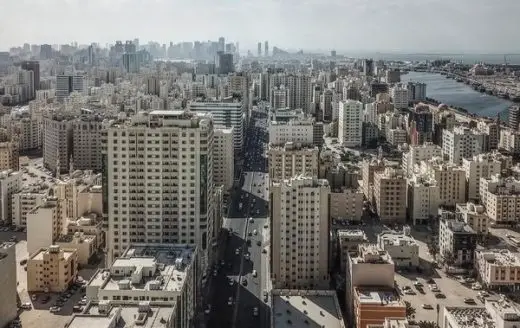
Photograph: Drone image of aerial view from Al Sharq Street overlooking Khalid Port, Sharjah
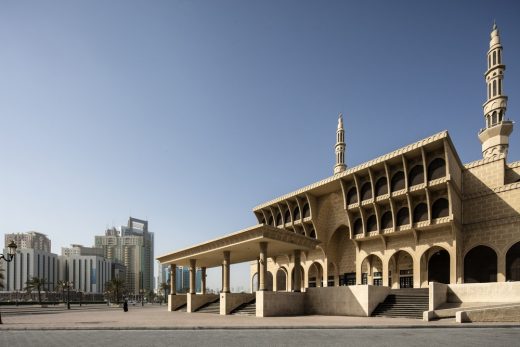
King Faisal Mosque, King Abdul Aziz Street, Sharjah, Office of Technical & Architectural Engineering & Consultancy, 1987
Sharjah Architecture Triennial, UAE
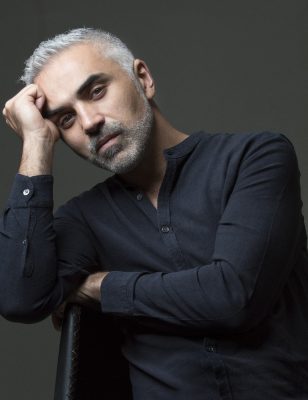
Adrian Lahoud Photograph © Rabee Younes
Sharjah Architecture Triennial, UAE images / information received 260923
Location: Sharjah, UAE
Dubai Architecture
Dubai Architecture Tours by e-architect
Design: Zaha Hadid Architects
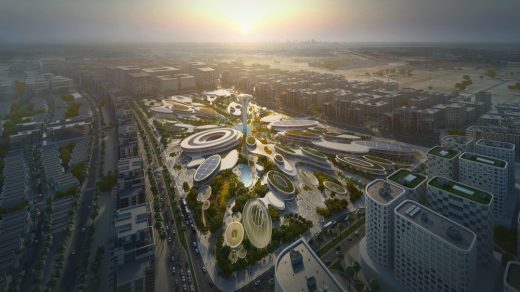
image courtesy of architects
Aljada Sharjah
Design: EDGE Architects
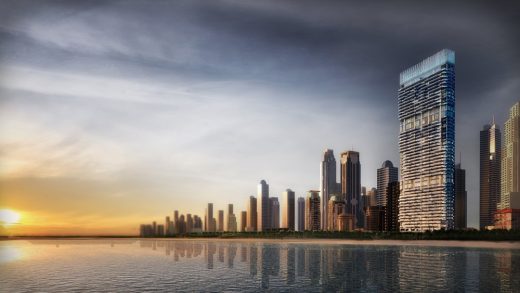
image courtesy of architects
1/JBR Tower Dubai
Architects: Foster + Partners
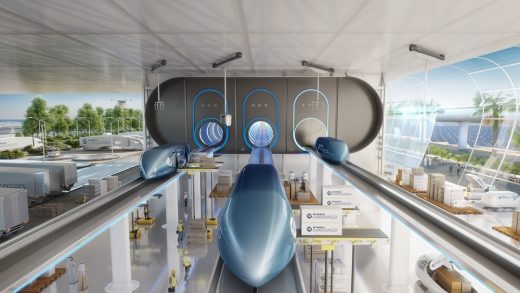
image Courtesy architecture office
DP World Cargospeed Dubai Building News
Design: METAFORM Architects
2020 Expo Dubai Luxembourg Pavilion Building
The Opus Dubai by Zaha Hadid Architects
Comments / photos for the Sharjah Architecture Triennial 2023, Dubai, UAE page welcome

